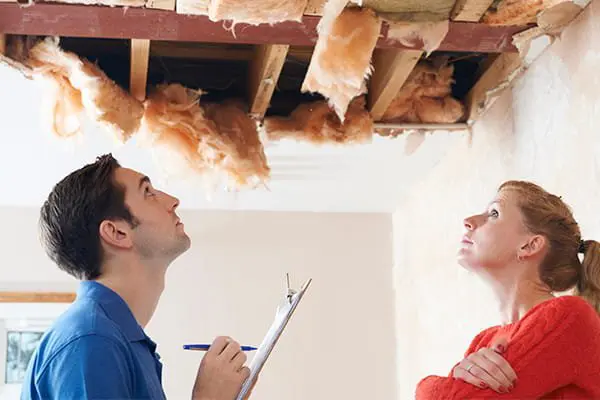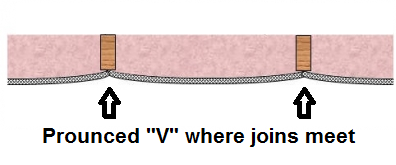Sagging Ceilings: are they are major structural defect?
When buying a property in Western Australia, it’s important to be aware of the terms and conditions set out in the Real Estate Institute of Western Australia (REIWA) contract. This legal document outlines the rights and obligations of both the buyer and the seller and is designed to protect both parties throughout the buying and selling process.
One of the key aspects of the REIWA contract is the provision for building inspections. This allows the buyer to conduct a thorough inspection of the property to identify any structural issues that may affect its value or safety. However, it’s important to note that the contract only requires the seller to fix any structural defects that affect the property. This means that issues such as cosmetic damage or minor defects may not necessarily need to be fixed by the seller.

Plasterboard ceilings are not a structural element of the home as they are a cladding/lining board and therefore a sagging ceiling is not considered a major structure defect. There is one circumstance where it is a structural defect and this is where there is termite damage to the timber ceiling joist that are supporting the ceiling, which in this case it would be a considered a structural defect as timber ceiling joists are a structural element of the roof structure. As such, if there is no termite damage then the seller is not typically required to fix a sagging ceiling under the terms of the REIWA contract.
This is a perfect example of Caveat Emptor (Buyer Beware). In this blog, we’ll explore the issue of sagging ceilings and provide some tips on what you should do if you encounter this problem.
What Causes Sagging Ceilings?
Sagging ceilings can be caused by a variety of factors including the age of the property, minimal glue and fixings at ceiling board installation, leaking roofs causing insulation inside the roof too be heavy, movement in the structure and foundation of the home and termite activity to the ceiling joists.
How to Identify Problems
Sagging ceilings are relatively easy to identify. The most obvious sign is a noticeable sag or dip in the ceiling. This can be seen from the ground, or you may need to climb a ladder to get a closer look. You may also notice cracks in the ceiling or gaps between the ceiling and walls. In some cases, you may also notice that the ceiling is beginning to separate from the walls around the cornice.
An obvious sign that a fixing system has given way is the ability to see a pronounced ‘V’ where the plasterboard sheets meet or join. This can be caused by the fixings in the centre of the plasterboard sheets letting go.

It’s important to note that in most cases, sagging ceilings are a non-structural issue which can usually be repaired relatively easily. However, it’s still important to have a professional building inspector check your ceiling to determine the cause of the sagging and whether or not it poses a risk to you and your home.
The Risks Involved
Sagging ceilings can pose a number of risks to your home and your family. In some cases, the ceiling can collapse, causing serious injury or even death.
The Western Australian Department of Commerce warns that “A ceiling collapse can cause serious injury to anyone present at the time of collapse and it can also cause extensive damage to a room’s contents and structure.” For this reason, it’s important to address sagging ceilings as soon as possible.
How to Deal with Sagging Ceilings
If you’ve identified a sagging ceiling in your home, the first step is to have it inspected by a professional building inspector. They will be able to determine the cause of the sagging and recommend the best course of action.
Repairing the ceiling may involve reinforcing the joists or adding additional support to the ceiling. In other cases, the entire ceiling may need to be replaced.
It’s important to work with a licensed and experienced contractor as they will be able to provide a detailed estimate for the repairs and ensure that the work is done safely and to a high standard.
Preventative Measures
Prevention is much easier than dealing with problems after the fact. There are several steps you can take to help prevent your ceilings from sagging:
- Regularly maintain your roof cover to ensure it doesn’t leak onto your ceilings.
- Avoid hanging heavy objects from the ceiling, such as chandeliers or heavy lighting fixtures.
- If you’re renovating your home, make sure to work with a licensed and experienced contractor who will ensure that the ceiling is properly installed and supported.
- Carry out annual termite inspections to the home.
- If you’re buying a home, it’s important to have a professional building inspection done before making an offer. This will help identify any potential issues with the home, including sagging ceilings, before you commit to purchasing it.
Ultimately, if you encounter sagging ceilings in your home, it’s important to take action to address the issue by having it inspected to determine the cause and whether or not it poses a risk to your home and family. Whether the cause is age, moisture, or poor construction, Total Home Inspections can assist to identify the best course of action for repairing or replacing the ceiling. By addressing the issue promptly, you can help prevent more serious problems from occurring and ensure the safety of your home and family.


